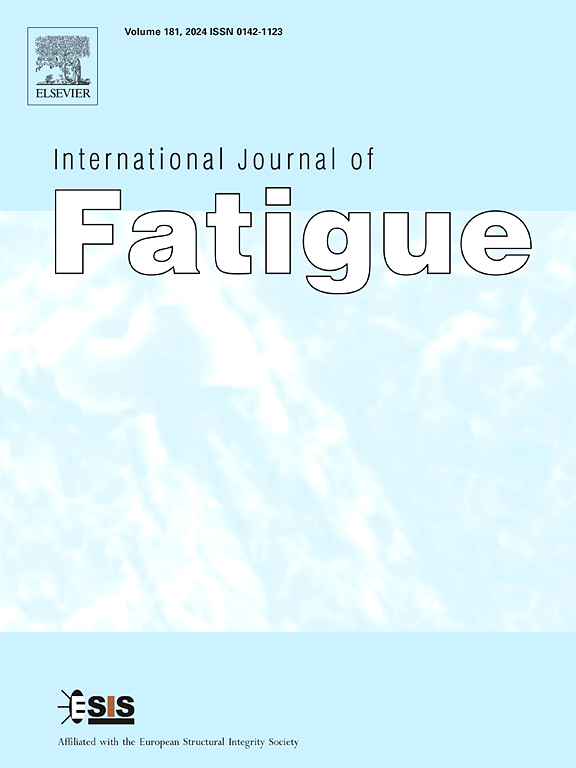Neural network approaches for real-time fatigue life estimation by Surrogating the rainflow counting method
IF 5.7
2区 材料科学
Q1 ENGINEERING, MECHANICAL
引用次数: 0
Abstract
Fatigue life estimation is critical for ensuring the safety and reliability of systems under cyclic loading. Traditional rainflow counting methods require exhaustive traversal of load histories, making them computationally expensive for real-time applications. To address this issue, this present study leverages the increasing demand for efficient high-cycle fatigue (HCF) life estimation methods, combining neural network surrogate modeling with physical principles to enhance both accuracy and computational speed. The Euler neural network (ENN) and the Runge-Kutta 4th-order neural network (RK4NN) for fatigue life estimation are proposed. These approaches are validated by comparing the results of rainflow counting with wind turbine damage ratios, demonstrating the accuracy achieves errors within 15 % for over 74 % of cases in the numerical stability range. Moreover, the RK4NN displayed superior generalization and fitting capacities across varied load conditions, effectively capturing early-stage damage growth while avoiding overfitting with the mean squared error 1.99 × 10−36. Additionally, the ENN and the RK4NN achieved the acceleration ratio of 19.53 × and 19.38 × respectively in comparison with the modified rainflow counting method (RCM). These findings underscore the practical value of the surrogate models in improving the real-time responsiveness and computational efficiency of fatigue life estimation frameworks, particularly in digital twin applications for industrial systems.
代替雨流计数法实时估计疲劳寿命的神经网络方法
疲劳寿命估算是保证系统在循环载荷作用下安全可靠运行的关键。传统的雨流计数方法需要详尽地遍历负荷历史,这使得它们在实时应用中计算成本很高。为了解决这一问题,本研究利用对高效高周疲劳(HCF)寿命估计方法日益增长的需求,将神经网络代理建模与物理原理相结合,以提高准确性和计算速度。提出了欧拉神经网络(ENN)和龙格-库塔四阶神经网络(RK4NN)的疲劳寿命估计方法。通过将雨流计数结果与风力涡轮机损伤比进行比较,验证了这些方法的有效性,结果表明,在数值稳定范围内,超过74%的情况下,精度误差在15%以内。此外,RK4NN在不同负载条件下表现出优异的泛化和拟合能力,有效地捕捉了早期损伤增长,同时避免了过拟合,均方误差为1.99 × 10−36。与改进的雨流计数法(RCM)相比,ENN和RK4NN的加速比分别达到19.53 ×和19.38 ×。这些发现强调了替代模型在提高疲劳寿命估计框架的实时响应性和计算效率方面的实用价值,特别是在工业系统的数字孪生应用中。
本文章由计算机程序翻译,如有差异,请以英文原文为准。
求助全文
约1分钟内获得全文
求助全文
来源期刊

International Journal of Fatigue
工程技术-材料科学:综合
CiteScore
10.70
自引率
21.70%
发文量
619
审稿时长
58 days
期刊介绍:
Typical subjects discussed in International Journal of Fatigue address:
Novel fatigue testing and characterization methods (new kinds of fatigue tests, critical evaluation of existing methods, in situ measurement of fatigue degradation, non-contact field measurements)
Multiaxial fatigue and complex loading effects of materials and structures, exploring state-of-the-art concepts in degradation under cyclic loading
Fatigue in the very high cycle regime, including failure mode transitions from surface to subsurface, effects of surface treatment, processing, and loading conditions
Modeling (including degradation processes and related driving forces, multiscale/multi-resolution methods, computational hierarchical and concurrent methods for coupled component and material responses, novel methods for notch root analysis, fracture mechanics, damage mechanics, crack growth kinetics, life prediction and durability, and prediction of stochastic fatigue behavior reflecting microstructure and service conditions)
Models for early stages of fatigue crack formation and growth that explicitly consider microstructure and relevant materials science aspects
Understanding the influence or manufacturing and processing route on fatigue degradation, and embedding this understanding in more predictive schemes for mitigation and design against fatigue
Prognosis and damage state awareness (including sensors, monitoring, methodology, interactive control, accelerated methods, data interpretation)
Applications of technologies associated with fatigue and their implications for structural integrity and reliability. This includes issues related to design, operation and maintenance, i.e., life cycle engineering
Smart materials and structures that can sense and mitigate fatigue degradation
Fatigue of devices and structures at small scales, including effects of process route and surfaces/interfaces.
 求助内容:
求助内容: 应助结果提醒方式:
应助结果提醒方式:


